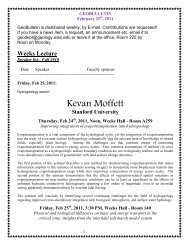Electron microprobe dating of monazite
Electron microprobe dating of monazite
Electron microprobe dating of monazite
Create successful ePaper yourself
Turn your PDF publications into a flip-book with our unique Google optimized e-Paper software.
46 ,I. M. Monte/et al. / Chentical Geolot,,y 1,';I (1996) 37-53<br />
conventional U-Pb age <strong>of</strong> 230 Ma given by Chinese<br />
authors for the emplacement <strong>of</strong> the granite. The rest<br />
<strong>of</strong> the population is younger than about 160 Ma.<br />
suggesting that an event has reset part <strong>of</strong> the crystals<br />
since that time.<br />
4.2. Old ages<br />
From a theoretical point <strong>of</strong> view, there is no upper<br />
limit for this method. The only limitations may arise<br />
from two features: (1) the absence <strong>of</strong> <strong>monazite</strong> in old<br />
rocks, and (2) possible restriction to the ability <strong>of</strong><br />
<strong>monazite</strong> to retain ~ Pb at very high concentrations.<br />
For the moment, the oldest sample we have studied<br />
is the 3.0 Ga Sinceni pluton (Trumbull, 1993) in<br />
Zwaziland. Monazites in this granite are moderately<br />
radioactive (0.04-0.45%, 2-14c~ Yh), very old, and<br />
contain 0.2 to 2% lead (Montel et al., 1994). This is<br />
not the maximum Pb content <strong>of</strong> a <strong>monazite</strong>: in a 2.5<br />
Ga sample, a crystal containing 11.5c7~ Th and 9.69/<br />
U, has a Pb content <strong>of</strong> 5.6cA. Actually, lead contents<br />
above 1% are very common in samples older than<br />
1.5 Ga, but even such old <strong>monazite</strong>s are most <strong>of</strong> the<br />
time optically clear, displaying no evidence <strong>of</strong><br />
metamictization. On the contrary, the surrounding<br />
minerals are totally altered lk~r more than 20 /xm<br />
around the <strong>monazite</strong>, except if it is quartz or garnet.<br />
As the formation <strong>of</strong> I atom <strong>of</strong> lead requires the<br />
emission <strong>of</strong> 6, 7, or 8 c~ particles, it can be calcu-<br />
lated that a 50 txm diameter <strong>monazite</strong> with 2% * Pb<br />
suffered 1015 OL emissions. The fact that very old<br />
<strong>monazite</strong> crystals are presently clear and non-meta-<br />
mict suggests that this mineral can easily restore the<br />
crystal bonds broken by ~x particles. Thus, we think<br />
that the only upper age limit <strong>of</strong> the method is the<br />
absence <strong>of</strong> <strong>monazite</strong> in very old rocks, since peralu-<br />
ruinous granites and metapelites, which are the rock<br />
types which contain <strong>monazite</strong> in abundance, are<br />
uncommon in old terranes.<br />
4.3. Small crystals<br />
The electron <strong>microprobe</strong> has an excellent spatial<br />
resolution, not only because the analysed volume is<br />
very small (less than 2 p~m in diameter) but also<br />
because it is possible to localize very precisely the<br />
analysed area, either by normal optical view or by<br />
electronic imaging. Monazites in high-grade meta-<br />
morphic rocks are usually rather big (100 p,m), but<br />
<strong>monazite</strong>s in granites are smaller, in the range 20-50<br />
Fig. 2. Backscattered electron (BSE) image <strong>of</strong> an arko~ic enclave in the Khartala volcano (Comoro Islands), showing bubbles (black). quartz<br />
and feldspars (medium grey), matrix (light grey), and the dated <strong>monazite</strong>, which is the bright spot in the quartz in the centre <strong>of</strong> the image.<br />
The scale bar in the enlarged portion is 10 ~rn.





